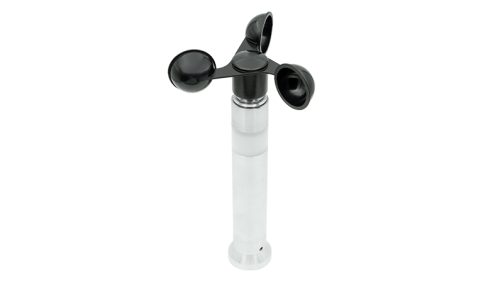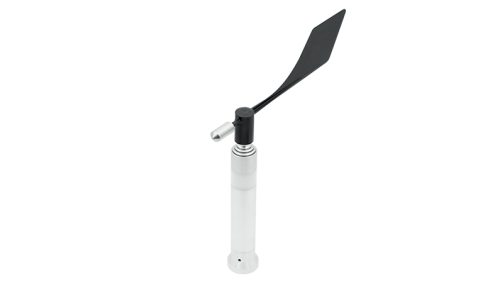SEVEN has launched two robust, heated wind sensors—one for wind speed and one for direction—designed specifically for cold and icy environments. These models use Hall effect technology, feature automatic heating with temperature sensors, and communicate via Modbus RTU over RS-485. Built for reliability, they’re ideal for applications in harsh climates, reducing downtime and manual maintenance needs.
What Are the New Heated Wind Sensors SEVEN Introduced?
SEVEN just rolled out two new and improved wind sensors built to handle freezing weather and ice:
- Wind Speed Sensor or Anemometer with Heating
- Wind Direction Sensor or Vane with Heating
Each model uses Hall effect sensor technology for accurate readings without physical contact and easily connects to systems using Modbus RTU over RS-485. They are built to keep working in tough weather conditions. In testing, our engineers were able to gather steady data even during below-zero storms in mountainous areas.
Why Is Heating Essential for Wind Sensors in Cold Climates?
Regular wind sensors often freeze in the cold, especially after snow or frost at night. When they stop working, it affects operations that rely on real-time wind data, like wind and solar farms.
To fix this, SEVEN added a built-in heater that kicks in when it gets cold. A PT1000 sensor monitors the temperature, and once it drops below 0°C, it triggers the heater automatically. This keeps the data flowing and reduces the need for someone to go out and manually defrost the sensors.
Technicians working in remote areas have long complained about wind sensors freezing up. These new models are designed to stop that from happening.
What Makes SEVEN’s Heated Wind Speed Sensor Stand Out?

Key Features:
- Three-cup style wind sensor using Hall effect tech
- Eight magnetic detection points for more precise measurements
- Heated cups and bearings
- Works between 0.8 to 50 m/s
- ±2% accuracy with 0.01 m/s resolution
- Energy-efficient heater (up to 23W)
- Built-in system checks using Modbus RTU
Unlike older sensors that rely on reed switches, SEVEN’s technology doesn’t wear out as fast. In tests, this sensor heated up from -40°C to +15°C in just two minutes and completely thawed out in less than two hours.
Even after freezing rain, it got back to work without needing any hands-on de-icing.
How Is the Heated Wind Direction Sensor Designed for Harsh Environments?

Technical Highlights:
- 360° wind direction output
- Starts working at 1.2 m/s
- 0.01° resolution and ±2% accuracy
- Uses Hall effect sensor instead of old-style potentiometers
- Heater turns on when it is colder than 10°C
- Durable aluminum body sealed against dust and water (IP65)
Both models share the same electronics. You can switch the top part (either cups or vane), which makes them easier to stock and slightly cheaper when buying both.
How Do These Sensors Connect via Modbus RTU?
These sensors easily hook up to SCADA, PLC, or logging systems using Modbus RTU over RS-485. This setup offers:
- Long-distance data transmission with less interference
- Unique device IDs for multi-sensor setups
- Consistent digital signals without analog signal loss
- Live sensor data in meters per second or degrees
Modbus RTU also cuts down on wiring work, saving time during installation.
What Are the Setup Details and Smart Features?
- Operates from -40°C to +70°C
- 24VDC power supply (20–28VDC), max 950mA
- Heater uses 0.80A, 18W and meets national standards
- LED lights show sensor status (blue = cold, red = heating)
- Mounts on 30 mm poles, weighs about 0.20 kg
SEVEN’s custom electronics include a special circuit that controls heating using low power. That’s perfect for remote sites where power is limited. The mounting system and LED lights also make it easier to check sensor status during tough weather.
How Do the Two Models Compare Technically?
| Feature | Wind Speed Sensor | Wind Direction Sensor |
| Heating Element | Yes | Yes |
| Communication | Modbus RTU (RS-485) | Modbus RTU (RS-485) |
| Operating Temp | -40°C to +70°C | -40°C to +70°C |
| Output | Speed (m/s) | Direction (degrees) |
| Sensor Type | Hall Effect | Hall Effect |
| Accuracy | ±2% | ±2% |
| Start Threshold | 0.8 m/s | 1.2 m/s |
| Heater Power | 0.80A, 18W | 0.80A, 18W |
| Weatherproof Rating | IP65 | IP65 |
Frequently Asked Questions (FAQ)
Q: How does the sensor heating work?
A: A PT1000 temperature sensor activates the heater when the temperature drops below a preset threshold.
Q: What communication protocol do these sensors use?
A: Both sensors use Modbus RTU protocol over RS-485 for reliable and long-range data transmission.
Q: Can I switch parts between the wind speed and direction sensors?
A: Yes, the top parts are interchangeable, making stocking and replacement easier.
Q: Are these sensors suitable for remote locations?
A: Absolutely. Their low-power heating system and durable build make them ideal for remote, cold-weather installations.
Why Are These Heated Sensors a Major Upgrade?
These heated wind sensors from SEVEN are a major upgrade for anyone needing reliable weather monitoring in cold, icy conditions. With accurate electronics, strong design, and smart features, they’re ready to take over where older models fall short.
If you are managing a site in a cold region, these sensors offer the kind of dependable performance you need, without having to send someone out to chip off ice.
